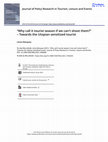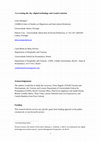Recent Publications by Lénia Marques
International Perspectives in Sport Tourism Management, 2024
This chapter provides insight into the motivations and participation surrounding cycling events b... more This chapter provides insight into the motivations and participation surrounding cycling events by analyzing data collected from 2016 in the Tour de France and Tour Down Under (Australia). The Cyclist Motivation Instrument (CMI) was used as a model that measures cycling motivations with the social-ecological theory as the foundation. Results show that those who are more active and participate in tours are more likely to attend a major cycling event, having a higher level of participation and engagement. More attention should be given to the increasing involvement of women in the events. Event managers and local administration could optimize these events as platforms for social interaction.

Journal of Policy Research in Tourism, Leisure and Events, 2021
This paper argues for increased awareness of local cultures through an educational approach, as i... more This paper argues for increased awareness of local cultures through an educational approach, as it is explored in the CultSense project. The tourist experience is a multi-layered phenomenon moderated by a dynamic relationship with the places visited and local populations. A holistic approach to tourism tensions and challenges, as well as a more pro-active attitude from all stakeholders involved are important in finding strategic solutions. The project proposes an alternative approach, developing bottom-up initiatives that give a voice to local actors and develop global intercultural awareness for (young) travellers. The dissemination of methodological and pedagogical tools by third parties should add to the body of knowledge around sensitized forms of tourism, stimulating non-demeaning and non-patronising attitudes achieved through a grassroots approach.

Event Management, 2021
Experience has been widely recognized as an essential part of an event’s success, but few studies... more Experience has been widely recognized as an essential part of an event’s success, but few studies have analyzed the processes underlying the event as social experience. This article contributes to a better understanding of the social processes that make an event a social interaction platform.
The social interaction processes that shape the event’s social experience is examined using a framework that brings together cocreation practices, group socialization, and interaction ritual chains. This exploratory study investigates the social interaction processes that shape the event’s social experience by developing a quantitative tool, the Event Social Interaction Scale (ESIS), which measures different social dimensions of the event experience. The ESIS was applied at a popular culture event, the festivities of São João in Northeast Brazil, and 625 survey responses were collected in 2016 and 2017. Findings suggest that multiple interaction rituals occur. People who are more directly and
actively engaged in the event are more likely to be open for contact with unknown others. The event becomes a multidimensional platform where different types of social interaction are not only possible but fostered. The ESIS contributes to charting the footprint of the event as social experience, revealing a similar experience footprint across different years of the study. The ESIS and the implications of its processes for the event can be useful for academics, practitioners, and policymakers interested in understanding and facilitating more engaging event social experiences.
Keywords: Social interaction; Experience; Socialization; Platform; Event Social Interaction Scale (ESIS)

Tourism Geographies An International Journal of Tourism Space, Place and Environment , 2020
In dark tourism affects are generated in a relational manner by the tourists and the locations vi... more In dark tourism affects are generated in a relational manner by the tourists and the locations visited by them. Exploring affective meanings of Banksy’s Dismaland via socio-spatial theories of emotion and affect is a way to contribute to the understanding of dystopian tourism. The dystopian touristic experience of Dismaland evolves from the interaction of a dystopian atmosphere, a displacement strategy and productive negative intensities. Whilst the affects produced vary according to the artist’s intentions, through innovative and politicised forms of dystopian dark tourism, Banksy creates atmospheres where productive negative intensities are able to be developed. In spite of the shades of dystopia and darkness in the artist’s work, a hopeful form of tourism could be generated. The implications are that affect in the dark tourism context has different layers of meaning where the materialising dystopian experiences, as simulacra, range from pure attraction to social change. Dismaland’s dark tourism experience reveals the role that political and ethical matters play in socio-affective encounters as exemplified by the commodification of the tourism industry, the Mediterranean refugee crisis and the glorified/sorrowful death of Diana, princess of Wales.
摘要
在黑暗旅游中, 游客和他们访问的地点是以一种关系的方式产生了感情。本文通过情绪和情感的社会空间理论探索班克斯的恐怖迪士尼的情感意义, 有助于理解反乌托邦式旅游。恐怖迪士尼的反乌托邦式旅游体验是从反乌托邦氛围、错位策略和产生的负面对比强度的相互作用演变而来的。尽管根据艺术家的不同意图, 班克西通过反乌托邦式的黑暗旅游的创新和政治化形式所产生的情感也有所不同, 但是班克西创造了一种氛围, 在这种氛围中, 生产性的负面对比强度能够被开发出来。尽管在艺术家的作品中有反乌托邦和黑暗的阴影, 但一种充满希望的旅游形式可能会产生。这意味着, 在黑暗旅游背景下的情感具有不同层次的意义, 其中物化的反乌托邦体验, 作为拟像, 从纯粹的吸引物到社会变革广泛存在。恐怖迪士尼的黑暗旅游体验揭示了政治和伦理问题在社会情感遭遇中的作用, 本文通过旅游业的商品化、地中海难民危机和威尔士王妃戴安娜的荣耀而悲伤的死亡等实例进行了说明。
Keywords: Affect, dark tourism, dystopia, Dismaland, Banksy
关键词: 情感, 黑暗旅游, 反乌托邦, 恐怖迪士尼, 班克斯

Cultura, Património e Turismo na Sociedade Digital (Vol. 3): Desafios de futuro , 2020
*** artigo em Português / article in Portuguese***
This paper explores the relationship between c... more *** artigo em Português / article in Portuguese***
This paper explores the relationship between culture and tourism in urban spaces, using Lisbon as a case study (based on observation, interviews and documentary research). We analyse on the one hand 1) synergies between culture and tourism that benefit the city and its various actors; and, on the other hand, 2) the need for urgent responses to challenges that significantly affect the quality of life of residents and tourists.
Greater mobility in urban spaces, including tourist activity, has brought opportunities and also challenges to the relationship between culture and tourism. The tourist is increasingly a participant and a co-creator of their own experiences, and therefore plays the multiple roles of visitor, cultural and creative tourist, temporary citizen and tourist-taxpayer.
We argue that cultural policies can resolve several tourist-urban myths. Although many cultural policy measures are more reactive than proactive, which makes it more difficult to use the city's immense resources strategically and effectively, in Lisbon, as in other cities, progress is gradually being made in developing a more holistic vision and stimulating collaborative and co-creative work between the different governance bodies.
Keywords: Cultural policy, cultural tourism, governance, cities, Lisbon
-----------------------------------------------------------------------------------------------------------
Neste artigo, e usando Lisboa como caso de estudo (observação, entrevistas e pesquisa documental), explora-se a relação da cultura e do turismo em espaços urbanos, procurando investigar, por um lado, 1) pontos de sinergia entre cultura e turismo que beneficiem a cidade e os seus vários actores; e, por outro lado, 2) apontar para respostas urgentes a desafios que influenciam sobremaneira a qualidade de vida de residentes e turistas.
A maior mobilidade em espaços urbanos, incluindo de turistas, tem trazido oportunidades, mas também desafios na relação da cultura e do turismo. O turista é cada vez mais participante e co-criador(a) da sua experiência, e deve ser visto nas suas múltiplas dimensões de visitante, turista cultural e criativo, cidadão temporário e turista-contribuinte.
Neste contexto, as políticas culturais podem contribuir para ultrapassar vários mitos turístico-urbanos. Apesar de muitas das medidas serem mais reactivas que proactivas, resultando numa dificuldade em planear mais estrategica e eficazmente o uso dos imensos recursos da cidade, em Lisboa, como noutras cidades, avança-se paulatinamente para a realização de que é necessário uma visão mais holística e um trabalho colaborativo e co-criativo entre os diversos organismos de governança.
Palavras-chave: políticas culturais, turismo cultural, governança, cidade, Lisboa
In: Cultura, Património e Turismo na Sociedade Digital (Vol. 3): Desafios de futuro . by Valeriano Piñeiro-Naval e Paulo Serra (Eds.) Coleção: Livros LabCom Ano da edição: 2020 ISBN: 978-989-654-679-3. Download PDF - 12960 KB
CREATIVE ENTREPRENEURS and TOURISM, 2020
This webinar will promote a dialogue on the relationship between creative entrepreneurship and to... more This webinar will promote a dialogue on the relationship between creative entrepreneurship and tourism. Our guest speakers are researchers in the field and artists or creative entrepreneurs with connections to tourism. We will focus on the Dutch creative and touristic scene, and the challenges the two sectors are facing through COVID-19, reflecting on how the integration of creativity and tourism can benefit people and places.
More information: http://www.atlas-euro.org/webinar_2020_june/tabid/354/language/en-US/Default.aspx
Registration: https://tinyurl.com/atlascreativeentrepreneurs2020
Literary tourism: theories, practice and case studies, 2019
The present chapter interrogates the image of the “literary city”, in particular with the emergen... more The present chapter interrogates the image of the “literary city”, in particular with the emergence of the UNESCO Creative Cities Network, and the title of “city of literature” (awarded since 2004). Considering the complex relationships between literature and place in global contexts, the first question to ask is How is the literary city configured and which elements are important in its recognition? To try to answer this question, we first delve into the manifold relationships between literature and the city, before addressing some main issues in literary tourism and city marketing. Afterwards, by analysing three cases of UNESCO’s cities of literature, configurating elements of the literary city are identified.
World Leisure Journal, 2019
Innovation has been widely debated in various fields. However, except for leisure innovation in a... more Innovation has been widely debated in various fields. However, except for leisure innovation in ageing and digital leisure, scant research has been done on the relationship between leisure and innovation. This article presents an overview of the field by mapping out the areas of innovation and leisure, suggesting also a taxonomy for innovations in leisure. Considering both supply and demand perspectives, a roadmap for future leisure and innovation research condensed into 10 priority areas is proposed.
World Leisure Journal
Innovation has been widely debated in various fields. However, except for leisure innovation in a... more Innovation has been widely debated in various fields. However, except for leisure innovation in ageing and digital leisure, scant research has been done on the relationship between leisure and innovation. This article presents an overview of the field by mapping out the areas of innovation and leisure, suggesting also a taxonomy for innovations in leisure. Considering both supply and demand perspectives, a roadmap for future leisure and innovation research condensed into 10 priority areas is proposed.
Current Issues in Tourism , 2019
Drawing on the network sociality concept, this article investigates network relationality princip... more Drawing on the network sociality concept, this article investigates network relationality principles relating to shareable tourism experiences through peer-to-peer platforms. The methodology is based on a case study approach, using qualitative research tools. Four key principles of network relationality emerge from the findings: temporary belongingness, a priori empathy, technology as bridge to face-to-face interactions, and relational spaces. More than mere social interaction, network relationality focuses on the intensity of temporary relationships which shape the tourist experience beyond accommodation services.
KEYWORDS: Network relationality, hospitality, tourism experience, host-guest interaction, sharing economy, sociality
Creating synergies between Cultural Policy and Tourism - Executive Summary , 2019
CREATING SYNERGIES BETWEEN CULTURAL POLICY AND TOURISM FOR PERMANENT AND TEMPORARY CITIZENS, 2018
In this report, we map out some of the basic issues that have emerged from previous analyses of t... more In this report, we map out some of the basic issues that have emerged from previous analyses of the relationship between cultural policies and tourism. In particular we highlight how both cultural policies and tourism are changing in response to wider driving factors, and how this is bringing culture and tourism, and permanent and temporary citizens, closer together.
Amsterdam, Copenhagen, Lisbon, Montréal and Rome are analysed in detail, and there are several references to the case of Barcelona.
Marketing & Tourism Review, 2018
A forma como anfitriões e hóspedes interagem entre si são abordadas neste trabalho pela hospitali... more A forma como anfitriões e hóspedes interagem entre si são abordadas neste trabalho pela hospitalidade em rede que, a partir dos resultados, pode ser apresentada uma relacionalidade. O objetivo do artigo foi compreender quais os aspectos fundamentais que embasam a relação entre hóspede e anfitrião em um Cama e Café da cidade de Olinda. Para a realização da pesquisa foram feitas análise temática a partir das revisões elaboradas pelos hóspedes no tripadvisor e da entrevista com os anfitriões proprietários do Cama e Café Olinda. Os resultados indicam a constituição de uma relação baseada em princípios de pertencimento temporário; estabelecimento de critérios pré-relação; associação entre trabalho e lazer por parte dos anfitriões; a construção de espaço relacional; a tecnologia como uma condição para propiciadora e mantenedora.

Tourism Management Perspectives, 2017
Concepts such as the “playable city” provide the basis of concrete projects for cities around the... more Concepts such as the “playable city” provide the basis of concrete projects for cities around the world facing the challenge of reconciling the needs of residents and tourists. By analysing a case study of Recife's initiative within the playable city concept, “Playtown”, this paper investigates how digital technologies can play a role in the co-creative remaking of a city, revitalising both its material and socio-cultural fabric, through the means of co-creation processes involving different stakeholders. These co-creative processes help to democratise citizenship as well as tourism (creative) practices, which are becoming more about participation and engagement. The connection to technology also makes the link between tangible and intangible culture more interactive and playful. This paper presents therefore new insights at the crossroads of urban development and creative tourism, by focusing on co-creation around digital technologies.
Papers by Lénia Marques
Routledge eBooks, Jun 24, 2024
Tourism & Management Studies, Apr 30, 2023










Uploads
Recent Publications by Lénia Marques
The social interaction processes that shape the event’s social experience is examined using a framework that brings together cocreation practices, group socialization, and interaction ritual chains. This exploratory study investigates the social interaction processes that shape the event’s social experience by developing a quantitative tool, the Event Social Interaction Scale (ESIS), which measures different social dimensions of the event experience. The ESIS was applied at a popular culture event, the festivities of São João in Northeast Brazil, and 625 survey responses were collected in 2016 and 2017. Findings suggest that multiple interaction rituals occur. People who are more directly and
actively engaged in the event are more likely to be open for contact with unknown others. The event becomes a multidimensional platform where different types of social interaction are not only possible but fostered. The ESIS contributes to charting the footprint of the event as social experience, revealing a similar experience footprint across different years of the study. The ESIS and the implications of its processes for the event can be useful for academics, practitioners, and policymakers interested in understanding and facilitating more engaging event social experiences.
Keywords: Social interaction; Experience; Socialization; Platform; Event Social Interaction Scale (ESIS)
摘要
在黑暗旅游中, 游客和他们访问的地点是以一种关系的方式产生了感情。本文通过情绪和情感的社会空间理论探索班克斯的恐怖迪士尼的情感意义, 有助于理解反乌托邦式旅游。恐怖迪士尼的反乌托邦式旅游体验是从反乌托邦氛围、错位策略和产生的负面对比强度的相互作用演变而来的。尽管根据艺术家的不同意图, 班克西通过反乌托邦式的黑暗旅游的创新和政治化形式所产生的情感也有所不同, 但是班克西创造了一种氛围, 在这种氛围中, 生产性的负面对比强度能够被开发出来。尽管在艺术家的作品中有反乌托邦和黑暗的阴影, 但一种充满希望的旅游形式可能会产生。这意味着, 在黑暗旅游背景下的情感具有不同层次的意义, 其中物化的反乌托邦体验, 作为拟像, 从纯粹的吸引物到社会变革广泛存在。恐怖迪士尼的黑暗旅游体验揭示了政治和伦理问题在社会情感遭遇中的作用, 本文通过旅游业的商品化、地中海难民危机和威尔士王妃戴安娜的荣耀而悲伤的死亡等实例进行了说明。
Keywords: Affect, dark tourism, dystopia, Dismaland, Banksy
关键词: 情感, 黑暗旅游, 反乌托邦, 恐怖迪士尼, 班克斯
This paper explores the relationship between culture and tourism in urban spaces, using Lisbon as a case study (based on observation, interviews and documentary research). We analyse on the one hand 1) synergies between culture and tourism that benefit the city and its various actors; and, on the other hand, 2) the need for urgent responses to challenges that significantly affect the quality of life of residents and tourists.
Greater mobility in urban spaces, including tourist activity, has brought opportunities and also challenges to the relationship between culture and tourism. The tourist is increasingly a participant and a co-creator of their own experiences, and therefore plays the multiple roles of visitor, cultural and creative tourist, temporary citizen and tourist-taxpayer.
We argue that cultural policies can resolve several tourist-urban myths. Although many cultural policy measures are more reactive than proactive, which makes it more difficult to use the city's immense resources strategically and effectively, in Lisbon, as in other cities, progress is gradually being made in developing a more holistic vision and stimulating collaborative and co-creative work between the different governance bodies.
Keywords: Cultural policy, cultural tourism, governance, cities, Lisbon
-----------------------------------------------------------------------------------------------------------
Neste artigo, e usando Lisboa como caso de estudo (observação, entrevistas e pesquisa documental), explora-se a relação da cultura e do turismo em espaços urbanos, procurando investigar, por um lado, 1) pontos de sinergia entre cultura e turismo que beneficiem a cidade e os seus vários actores; e, por outro lado, 2) apontar para respostas urgentes a desafios que influenciam sobremaneira a qualidade de vida de residentes e turistas.
A maior mobilidade em espaços urbanos, incluindo de turistas, tem trazido oportunidades, mas também desafios na relação da cultura e do turismo. O turista é cada vez mais participante e co-criador(a) da sua experiência, e deve ser visto nas suas múltiplas dimensões de visitante, turista cultural e criativo, cidadão temporário e turista-contribuinte.
Neste contexto, as políticas culturais podem contribuir para ultrapassar vários mitos turístico-urbanos. Apesar de muitas das medidas serem mais reactivas que proactivas, resultando numa dificuldade em planear mais estrategica e eficazmente o uso dos imensos recursos da cidade, em Lisboa, como noutras cidades, avança-se paulatinamente para a realização de que é necessário uma visão mais holística e um trabalho colaborativo e co-criativo entre os diversos organismos de governança.
Palavras-chave: políticas culturais, turismo cultural, governança, cidade, Lisboa
In: Cultura, Património e Turismo na Sociedade Digital (Vol. 3): Desafios de futuro . by Valeriano Piñeiro-Naval e Paulo Serra (Eds.) Coleção: Livros LabCom Ano da edição: 2020 ISBN: 978-989-654-679-3. Download PDF - 12960 KB
More information: http://www.atlas-euro.org/webinar_2020_june/tabid/354/language/en-US/Default.aspx
Registration: https://tinyurl.com/atlascreativeentrepreneurs2020
KEYWORDS: Network relationality, hospitality, tourism experience, host-guest interaction, sharing economy, sociality
Executive summary (English): http://www.agenda21culture.net/sites/default/files/informe_2018_bcn_cultural_policy_and_tourism_-_executive_summary_-_eng.pdf
Full report: http://www.agenda21culture.net/sites/default/files/files/cities/content/informe_2018_bcn_cultural_policy_and_tourism_-eng_1.pdf
Amsterdam, Copenhagen, Lisbon, Montréal and Rome are analysed in detail, and there are several references to the case of Barcelona.
Papers by Lénia Marques
The social interaction processes that shape the event’s social experience is examined using a framework that brings together cocreation practices, group socialization, and interaction ritual chains. This exploratory study investigates the social interaction processes that shape the event’s social experience by developing a quantitative tool, the Event Social Interaction Scale (ESIS), which measures different social dimensions of the event experience. The ESIS was applied at a popular culture event, the festivities of São João in Northeast Brazil, and 625 survey responses were collected in 2016 and 2017. Findings suggest that multiple interaction rituals occur. People who are more directly and
actively engaged in the event are more likely to be open for contact with unknown others. The event becomes a multidimensional platform where different types of social interaction are not only possible but fostered. The ESIS contributes to charting the footprint of the event as social experience, revealing a similar experience footprint across different years of the study. The ESIS and the implications of its processes for the event can be useful for academics, practitioners, and policymakers interested in understanding and facilitating more engaging event social experiences.
Keywords: Social interaction; Experience; Socialization; Platform; Event Social Interaction Scale (ESIS)
摘要
在黑暗旅游中, 游客和他们访问的地点是以一种关系的方式产生了感情。本文通过情绪和情感的社会空间理论探索班克斯的恐怖迪士尼的情感意义, 有助于理解反乌托邦式旅游。恐怖迪士尼的反乌托邦式旅游体验是从反乌托邦氛围、错位策略和产生的负面对比强度的相互作用演变而来的。尽管根据艺术家的不同意图, 班克西通过反乌托邦式的黑暗旅游的创新和政治化形式所产生的情感也有所不同, 但是班克西创造了一种氛围, 在这种氛围中, 生产性的负面对比强度能够被开发出来。尽管在艺术家的作品中有反乌托邦和黑暗的阴影, 但一种充满希望的旅游形式可能会产生。这意味着, 在黑暗旅游背景下的情感具有不同层次的意义, 其中物化的反乌托邦体验, 作为拟像, 从纯粹的吸引物到社会变革广泛存在。恐怖迪士尼的黑暗旅游体验揭示了政治和伦理问题在社会情感遭遇中的作用, 本文通过旅游业的商品化、地中海难民危机和威尔士王妃戴安娜的荣耀而悲伤的死亡等实例进行了说明。
Keywords: Affect, dark tourism, dystopia, Dismaland, Banksy
关键词: 情感, 黑暗旅游, 反乌托邦, 恐怖迪士尼, 班克斯
This paper explores the relationship between culture and tourism in urban spaces, using Lisbon as a case study (based on observation, interviews and documentary research). We analyse on the one hand 1) synergies between culture and tourism that benefit the city and its various actors; and, on the other hand, 2) the need for urgent responses to challenges that significantly affect the quality of life of residents and tourists.
Greater mobility in urban spaces, including tourist activity, has brought opportunities and also challenges to the relationship between culture and tourism. The tourist is increasingly a participant and a co-creator of their own experiences, and therefore plays the multiple roles of visitor, cultural and creative tourist, temporary citizen and tourist-taxpayer.
We argue that cultural policies can resolve several tourist-urban myths. Although many cultural policy measures are more reactive than proactive, which makes it more difficult to use the city's immense resources strategically and effectively, in Lisbon, as in other cities, progress is gradually being made in developing a more holistic vision and stimulating collaborative and co-creative work between the different governance bodies.
Keywords: Cultural policy, cultural tourism, governance, cities, Lisbon
-----------------------------------------------------------------------------------------------------------
Neste artigo, e usando Lisboa como caso de estudo (observação, entrevistas e pesquisa documental), explora-se a relação da cultura e do turismo em espaços urbanos, procurando investigar, por um lado, 1) pontos de sinergia entre cultura e turismo que beneficiem a cidade e os seus vários actores; e, por outro lado, 2) apontar para respostas urgentes a desafios que influenciam sobremaneira a qualidade de vida de residentes e turistas.
A maior mobilidade em espaços urbanos, incluindo de turistas, tem trazido oportunidades, mas também desafios na relação da cultura e do turismo. O turista é cada vez mais participante e co-criador(a) da sua experiência, e deve ser visto nas suas múltiplas dimensões de visitante, turista cultural e criativo, cidadão temporário e turista-contribuinte.
Neste contexto, as políticas culturais podem contribuir para ultrapassar vários mitos turístico-urbanos. Apesar de muitas das medidas serem mais reactivas que proactivas, resultando numa dificuldade em planear mais estrategica e eficazmente o uso dos imensos recursos da cidade, em Lisboa, como noutras cidades, avança-se paulatinamente para a realização de que é necessário uma visão mais holística e um trabalho colaborativo e co-criativo entre os diversos organismos de governança.
Palavras-chave: políticas culturais, turismo cultural, governança, cidade, Lisboa
In: Cultura, Património e Turismo na Sociedade Digital (Vol. 3): Desafios de futuro . by Valeriano Piñeiro-Naval e Paulo Serra (Eds.) Coleção: Livros LabCom Ano da edição: 2020 ISBN: 978-989-654-679-3. Download PDF - 12960 KB
More information: http://www.atlas-euro.org/webinar_2020_june/tabid/354/language/en-US/Default.aspx
Registration: https://tinyurl.com/atlascreativeentrepreneurs2020
KEYWORDS: Network relationality, hospitality, tourism experience, host-guest interaction, sharing economy, sociality
Executive summary (English): http://www.agenda21culture.net/sites/default/files/informe_2018_bcn_cultural_policy_and_tourism_-_executive_summary_-_eng.pdf
Full report: http://www.agenda21culture.net/sites/default/files/files/cities/content/informe_2018_bcn_cultural_policy_and_tourism_-eng_1.pdf
Amsterdam, Copenhagen, Lisbon, Montréal and Rome are analysed in detail, and there are several references to the case of Barcelona.
This volume examines the topics of conflict, memory and identity through a collection of insightful viewpoints and perspectives, reflecting a diversity of cultural and social backgrounds, which combine to give a contemporary interdisciplinary analysis of cultural interactions and their effects. The themes covered by the authors, such as memory and forgetfulness, migration, ecological concerns, mixed cultural landscapes, storytelling, postcolonial trauma and internal struggles for identity, offer the reader a fascinating glimpse into the ongoing and evolving social debate about identity and purpose.
Contents:
Contents: Lénia Marques/Maria Sofia Pimentel Biscaia/Glória Bastos: Introduction - João Luís Jesus Fernandes: Dynamics of Cultural Landscapes, Identities and Diffusion Processes - Christian Hummelsund Voie: Permeable Borderlines: Discovering an Ecocritical and Architectural Ecotone - Joana Miranda: Women's Journeys to Portugal: Identitary Reconstructions and Memories of the Country of Origin - Belén Martín-Lucas: «The Heaviness of a History that Couldn't Leave»: Diasporic Trauma in Multicultural Canada - Rosa Maria Sequeira: Stories of Lebanese Migration in Brazilian Literature - Glória Bastos: Revisiting History and Identity: National Heroes in Contemporary Portuguese Theatre - Manuela Malheiro Ferreira/Manuela Tavares: School Manuals in Estado Novo: The Reproduction of a Sexist and Colonialist Culture - Maria Isabel João: The Colonial Journey: Confrontations between Europe and Africa - Maria Sofia Pimentel Biscaia: Colluding Strokes: Imperialistic Brutality and Affection in André Brink's The Other Side of Silence - Joana Passos: Heart of Violence and Healing Words: Europe, Decolonization and Mobility - Lars Jensen: From Anglophone to Danophone Postcolonialism: The Difficulties of Developing a Critique - Lénia Marques: Creating Stories, Mapping Memories: Nicolas Bouvier at Intercultural Crossings - Dionísio Vila Maior: Bakhtinian Dialogism and the Adding of Meaning.
Journal of Tourism Consumption and Practice, Volume 4, 2012
Keywords: creativity, creative tourism, cultural tourism, creative experiences, network society.
(Exploring Creative Tourism: Editors Introduction)
Leurs auteurs se penchent sur quelques engagements et enjeux qui se cristallisent autour de cette thématique, ainsi que sur leurs effets dans des domaines aussi divers que ceux de la création littéraire et les espaces de communication, les industries culturelles et la gestion des institutions littéraires, la traduction, les pratiques de lecture, notamment celles qui font appel à de nouveaux systèmes d’information et de communication.
Le contexte historial dans lequel elles ont émergé et se sont institutionnalisées demeure-t-il encore valable alors que d’autres soucis et d’autres thématiques sont venus s’immiscer dans
le fait littéraire jusqu’à, selon d’aucuns, en décaractériser la nature ou la raison d’être?
[éditorial]
Paper in: van Niekerk, Mathilda and Couto, Ubaldino (Dino), "4th International Conference on Events (ICE) Conference Proceedings" (2017). 4th International Conference on Events (ICE) 2017. 11. http://stars.library.ucf.edu/ice2017/2017/tuesday/11
[excerpt from the introduction of the chapter]
Inês de Castro é lontana dal meraviglioso dei racconti tradizionali. Non è una felice storia d’amore
o di risoluzione di ostacoli: è una tragedia sconcertante, tra le più forti della storia portoghese. Le
terribili traversie di cui questa donna è stata protagonista hanno lasciato una forte impronta nella
cultura e nell’identità di un Portogallo inevitabilmente consacrato all’amore, alla morte e alla
nostalgia. Così, tra Storia, mito e leggenda, la figura di Inês imprime da secoli il suo segno nella
letteratura, nelle arti e nella mitologia portoghese - e non solo in quelle 1.
Dama di compagnia di D. Constança Manuel, principessa di Castiglia2, la galiziana Inês Peres
de Castro, figlia di D. Pedro Fernandes de Castro, nipote (illegittimo) di D. Sancho IV di Castiglia,
giunge alla corte portoghese intorno al 1340.
La Castiglia era un regno vicino al Portogallo e spesso suo nemico. Motivati da una politica
di alleanze tra regni, i matrimoni del tempo tentavano di garantire, nella misura del possibile (e
degli interessi), buoni rapporti e uno stato di pace. In questo contesto, le principesse costituivano
una sorta di moneta di scambio tra regni. Tale fu il caso di D. Constança Manuel, principessa
di Castiglia andata in sposa a D. Pedro, figlio di D. Afonso IV di Portogallo (penultimo re della
dinastia di Borgogna) e principe ereditario. In seguito ad alleanze fatte e disfatte da parte del
Portogallo e della Castiglia, Constança e Pedro avrebbero celebrato il loro matrimonio nel 1340,
anno in cui Inês seguì D. Constança per viverle accanto come dama di compagnia alla corte
portoghese.
[Introduction, p. 117]
"In this chapter we will focus on the work of the Swiss traveller, Nicolas Bouvier (1929-1998), seeking to understand how motivations and, in particular, emotions, feelings, sensations and impressions experienced along the journey are artistically expressed. This study will focus firstly on the interrelationship between travelling/tourism and emotions in the work of one of the landmark writers of travel literature from the second half of the 20th century, and secondly on how this work has encouraged others to travel, write and express themselves by artistic means in the context of an interpretation of this emotional framework."
"The story of Nicolas Bouvier (Geneva, 1929-1998) is one that starts before his most marking long journey to Asia. The story of the traveller is merged with the story of his journeys and, above all, with the experiences of “Otherness”. In this sense, travelling is an intercultural crossing that enables the encounter between different cultures performed by the traveller (the “Self”) and by the “Other”.""
L’étude du fragment et de l’écriture fragmentaire s’est développée depuis quelques années, sans que pour autant des réponses consensuelles ne surgissent. Si cette pratique est devenue courante après la Seconde Guerre mondiale, elle a pourtant des pionniers. Dans l’univers francophone littéraire européen non français, Charles-Albert Cingria (Genève, 1883-1954) et Paul Nougé (Bruxelles, 1895-1967) sont deux auteurs représentatifs de cette modalité d’écriture, ayant introduit de nombreuses stratégies qui seraient explorées postérieurement. Se concentrant sur l’œuvre publiée et inédite des deux auteurs, la présente étude cherche à dégager les axes d’une pensée littéraire qui s’actualise en pratiques d’écriture fragmentaire, dans des espaces génologiques et thématiques de frontière. Dans ce cadre, le lecteur, expérimentant constamment la violence métamorphique textuelle, joue un rôle primordial.
[in English]
The study of the fragment and of fragmentary writing has increased in recent years. However, consensual answers have been difficult to find. If this practice has become regular since the Second World War, it certainly had precursors. In the francophone non French literary European world, Charles-Albert Cingria (Geneva, 1883-1954) and Paul Nougé (Brussels, 1895-1967) are two outstanding authors of this writing modality, who introduced several strategies that were subsequently to be developed. The present study, based in the published and unpublished work of both authors, aims to identify the guidelines of a literary conception materialised in practices of fragmentary writing, in generic and thematic spaces of frontier. Within this context, the reader, permanently experiencing metamorphic textual violence, plays a major role.
[in Portuguese]
O estudo do fragmento e da escrita fragmentária tem vindo a desenvolver-se nos últimos anos, sem que no entanto respostas consensuais apareçam. Se esta prática se tornou muito comum depois da Segunda Guerra Mundial, ela tem pioneiros. No universo literário francófono europeu não francês, Charles-Albert Cingria (Genebra, 1883-1954) e Paul Nougé (Bruxelas, 1895-1967) são autores marcantes desta prática de escrita, tendo introduzido várias estratégias que viriam a ser desenvolvidas posteriormente. Centrando-se na obra publicada e inédita dos dois autores, este estudo procura identificar as linhas mestras de um pensamento literário que se actualiza em práticas de escrita fragmentária, em espaços genológicos e temáticos de fronteira. Neste contexto, o leitor, experimentando permanentemente a violência metamórfica textual, assume um papel determinante.
Co-authored with: Mireia Iglesias and Yvonne Klerks
URL: http://indd.adobe.com/view/445117b4-9e8e-49aa-8882-2b340de30593
AI summary
Creative districts are emerging around the world, serving as catalysts for urban development, creative regeneration, and cultural renewal. Here are some notable creative districts from different parts of the world:
Bairro Alto, Lisbon, Portugal: This historic neighborhood is known for its cultural events and has been a catalyst for the publication of the interactive e-book "Creative Districts around the World"
1
.
Tokyo's Roppongi Design District, Japan: Known for its design-focused enclaves, Roppongi is a popular destination for design lovers
3
.
London's Shoreditch Neighborhood, UK: Shoreditch is a hub for creative industries and has a vibrant street art scene
3
.
Helsinki, Finland: Helsinki is a Creative City of Design by UNESCO and has a thriving design district
3
.
Miami's Buena Vista Neighborhood, USA: This neighborhood came of age in the 1990s with a bevy of furniture and home decor showrooms
3
.
Buenos Aires' Metropolitan Design Center (CMD), Argentina: Located in a former fish market, CMD is the largest design center in Latin America
3
.
Maboneng Precinct, Johannesburg, South Africa: This area offers a mix of restaurants, boutiques, galleries, and coffee shops housed within a collection of old manufacturing buildings
3
.
Kødbyen (Meatpacking District), Copenhagen, Denmark: This area is divided into three separate 'meat cities' and has been partially repurposed for culture and leisure
5
.
Embajadores, Madrid, Spain: Known for its street art and cultural events, Embajadores is a vibrant art neighborhood in Madrid
5
.
798 Art Zone, Beijing, China: This former military-industrial facility has been transformed into a nexus of global art and commerce
5
.
These creative districts are dynamic spaces that reflect the ongoing changes in urban development and the relationship between creativity and urban experience.
Panyik, E. (2014). Transformation through the revival of industrial heritage. The Zsolnay quarter, Pécs, Hungary.